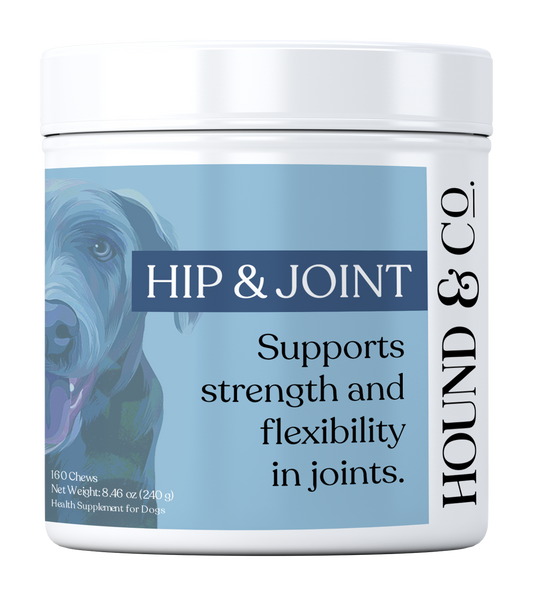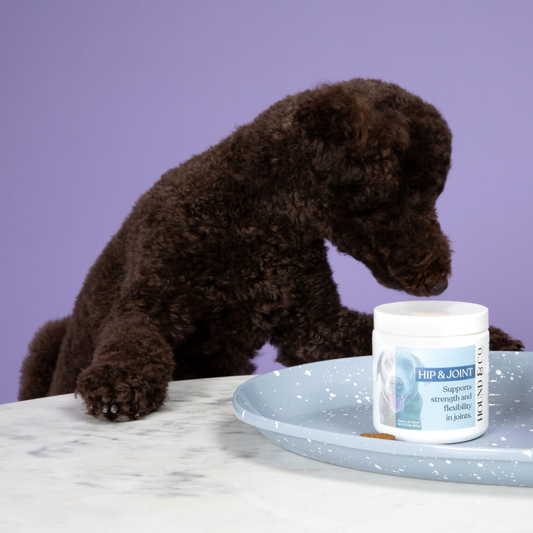Is Your Dog Slowing Down… or in Pain?

Vet Reviewed by Dr. Jacob Klos, DVM

As our dogs get older, we expect them to slow down. They nap more, take fewer zoomies around the house, and maybe start skipping stairs or long walks. But how can you tell if your dog is simply aging—or if that slowdown is a sign of pain?
It’s a question every dog owner eventually faces. And while some physical changes are normal with age, others may point to underlying discomfort that needs attention. Understanding the difference could greatly improve your dog’s quality of life.
How Dogs Hide Pain
Dogs are incredibly stoic animals. In the wild, showing signs of weakness could mean falling behind the pack or becoming vulnerable to predators. As a result, many dogs are hardwired to mask pain—even when it’s severe.
This means the early signs of discomfort are often subtle. Your dog may not whine, cry, or visibly limp at first. Instead, they might simply move less, avoid stairs, or hesitate before jumping on the couch. To the untrained eye, this can look like “normal aging.” But it might be your dog’s only way of saying, “Something doesn’t feel right.”
10 Signs Your Dog Might Be in Pain
Here are some common signs that your dog may be dealing with chronic pain—especially in their joints, muscles, or spine:
- Slower movement or reluctance to get up
- Stiffness after lying down, especially in the morning
- Limping or favoring one side of the body
- Hesitation or refusal to use stairs, jump on furniture, or get in the car
- Increased sleeping or lower energy levels
- Changes in appetite or water consumption
- Excessive licking or chewing on a specific area (e.g., wrists, hips, back legs)
- Behavior changes like irritability, restlessness, or withdrawal
- Whimpering, whining, or panting without a clear reason
- Hunched back or an arched, guarded posture
If you’ve noticed even a few of these behaviors consistently, it’s time to dig deeper.
Is It Just Old Age?
Aging can cause a natural reduction in energy and mobility. Senior dogs may take longer to recover from activity, tire more quickly, or need more rest throughout the day. But what’s not normal is persistent pain, obvious discomfort, or a significant drop in quality of life.
Ask yourself:
- Is this change sudden or gradual?
- Is my dog avoiding activities they used to love?
- Does my dog seem uncomfortable when touched in certain areas?
- Has their personality or behavior changed?
Gradual aging happens over time and tends to be consistent. Pain, on the other hand, often brings sudden hesitation, stiffness, or distress—and it typically gets worse without intervention.
Common Causes of Pain in Dogs
If your dog is in pain, it could be related to any of the following conditions:
- Osteoarthritis: One of the most common causes of chronic pain in older dogs, affecting joints and mobility.
- Hip dysplasia: A structural issue common in large breeds that causes the hip joint to become unstable and painful.
- Intervertebral disc disease (IVDD): A spinal condition that can lead to nerve pain or mobility loss.
- Injuries or trauma: Even mild sprains or muscle strains can cause lasting discomfort.
- Dental issues: Pain from infected teeth or gums may cause changes in appetite or behavior.
- Cancer or internal conditions: Tumors, cysts, or organ issues can all produce pain without visible signs.
How to Confirm If Your Dog Is in Pain
If you’re unsure, the best step is to schedule a checkup with your veterinarian. They may recommend:
- A physical exam to detect sensitivity or restricted movement
- X-rays or ultrasounds to look for joint changes or internal issues
- Blood tests to rule out inflammation or organ dysfunction
- A short trial of pain medication to see if symptoms improve
Sometimes, just a few days on an anti-inflammatory drug or joint supplement can be enough to confirm your suspicions—especially if your dog suddenly becomes more energetic or mobile.
Supporting Dogs with Chronic Pain
Once pain is diagnosed, a combination of strategies can help your dog feel better, including:
- Veterinary care: NSAIDs, laser therapy, acupuncture, or surgery depending on the issue
- Supplements: Joint-support formulas with glucosamine, MSM, turmeric, or collagen
- Weight management: Reducing pressure on joints through a healthy weight
- Comfort upgrades: Orthopedic beds, traction mats, or ramps for stairs and furniture
- Gentle exercise: Short walks, swimming, or at-home mobility routines
When in Doubt, Trust Your Instincts
No one knows your dog better than you. If something seems off, even if it's subtle, don't ignore it. Dogs can't speak, but their bodies do—and when you listen, you can make a huge difference in their comfort and happiness.
Slowing down might be part of getting older… but pain doesn’t have to be.









